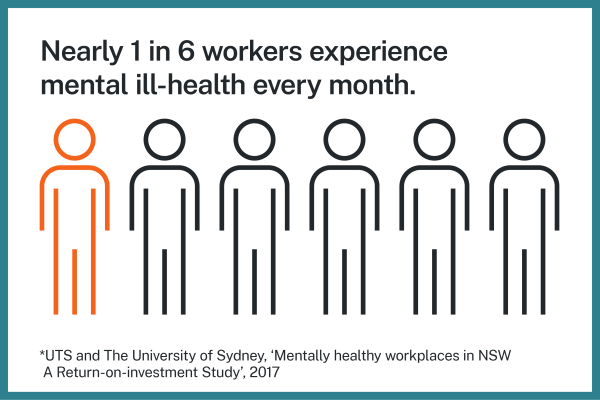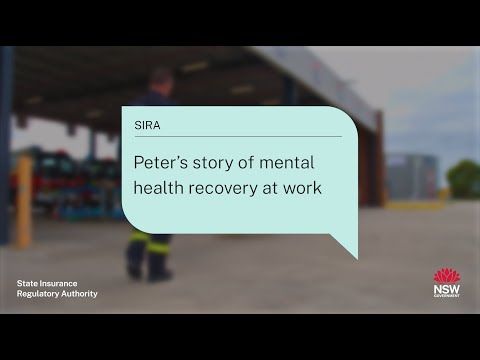Take action to be a mentally healthy workplace
Here are practical actions you can take to be a productive, safe workplace.
Key information
- Mentally healthy workplaces continually promote good mental health and manage risks to mental health.
- Safe work practices and a positive work culture are critical to a mentally healthy workplace.
- Mentally healthy workplaces encourage workers to seek help early and support recovery at work.
- There are simple, practical actions you can take immediately to promote workplace mental health.
Promote good health
Promoting mental health and wellbeing in the workplace can help create a supportive and inclusive culture while also reducing stigma and opening up communication.
Meaningful promotion of mental health must start at the top. All levels of leadership must commit to building and supporting a mentally healthy workplace for all.
There are five key actions you can take to help ensure mental health is top of mind in your workplace.
Talk and listen
Our day-to-day interactions have the biggest impact on workplace culture. Take opportunities to check in with staff and colleagues. Get to know them and build strong relationships. This will open the door for people to be more comfortable to seek help when needed.
Use regular one-on-one meetings with staff to check in on workloads, expectations, training needs and the requirements of their role. Regular discussion on these topics can prevent issues that cause mental ill-health.
If you notice changes in a team member's performance or behaviour, check in with them. Let them know you've noticed changes and seek to understand what could be going on for them and what they might need support with.
Other ideas to engage staff on mental health topics:
- Take opportunities like R U OK? Day and Mental Health Month to hold social events, share case studies and promote resources.
- Regularly demonstrate a business-wide commitment to a mentally healthy workplace through internal communications, tools and resources.
- Train peer support leaders or mental health champions to create a wide network of people for staff to seek support.
Have active systems, policies and procedures
Having systems in place to mitigate risks and ensure success is part of running a profitable business. The same principles apply to creating a mentally healthy workplace and being an employer of choice.
Having mental health and wellbeing integrated into your safety systems and documented in policies and procedures can help everyone understand the business expectations around behaviour, reporting and support. It also demonstrates your leadership's commitment to staff health and safety.
Mental health policies work best when they are clearly and effectively communicated to everyone.
Make sure that you:
- Seek feedback from staff on draft policies to make sure they are easily understood and work for your people.
- Share them with your team when they do their induction or when a policy is updated, created or breached.
- Make the policies easily accessible to everyone (without people needing to ask for them).
- Review your safety systems regularly including your policies and procedures to make sure they keep up with business changes.
Our free workplace mental health coaching can help you create or review these policies.
Support a flexible workplace
By being flexible in the way work is delivered, you will support the needs of your team and create benefits including improved work-life balance, increased productivity, reduced absenteeism and improved morale.
In some circumstances, employees have a right to request flexible working arrangements.
Flexibility will look different in each workplace, but the aim is to provide your team with options that work best for their personal circumstances and your business needs.
Flexibility can include:
- different daily or weekly work hours and/or start and finish times
- staggered rosters
- part-time or job share roles
- hybrid working from home and/or remotely.
Build your flexible workplace by:
- talking to each of your workers to understand what works best for them
- building a flexible working policy that sets out the principles for everyone to follow to ensure consistent and fair access to flexibility
- checking in and reviewing regularly to see if anything can be improved.
Flexible working resources
- Our policy resource kit can help you create a flexible workplace.
- Fair Work Ombudsman has information on flexible working flexible working legal requirements.
- The Australian Government's Workplace Gender Equality Agency has more resources to help create flexible workplaces in all industries.
- Watch our videos for tips on how support yourself and support your team while working remotely or from home.
Case study
Western Earthmoving improved work-life balance by moving from a six-day to a five-day working week. See how they did it.

Creating a mentally healthy workplace – Western Earthmoving
Recognise good work
Recognising the efforts and achievements of staff makes them feel that their work is acknowledged and valued. This can lead to higher engagement, increased productivity and positive morale.
Regular discussions on task performance, overall performance reviews, and development planning create opportunities to provide recognition.
You can give recognition through formal or informal rewards. You might consider starting a rewards program, sharing positive feedback, celebrating both individual and team wins, and providing opportunities for career development.
Provide training
Workplace mental health training can help you and your team promote and manage wellbeing. It can also help you better understand how to look after yourself and support others at work.
There are three types of training that support mental health at work:
- Prevention – how to stay mentally well.
- Responding – how to act on warning signs of mental ill-health.
- Recovery – how to support people with mental illness to recover.
Workplace mental health training teaches you how to provide the right support at the right time.
Choose a workplace mental health training provider that:
- delivers training via a mode of delivery that suits you
- delivers training tailored to your business (for example, the factors you need addressed) or your industry
- delivers a program that has been proven to achieve results
- provides a facilitator who is suitably trained and experienced.
Training resources
For more advice on choosing the right training for your business, read our training resource kit.
Case study
Manufacturing business TrendPac took up our free training offer and have seen the benefits.

Creating a mentally healthy workplace – TrendPac
Manage risks by creating a safe workplace with a good culture
A mentally safe workplace is designed in the same way as a physically safe workplace.
A risk management approach to controlling exposure to factors that are known to impact mental health can ensure staff safety and create a culture that enables staff to bring their best to work.
The following actions should be part of your part of your plan to a creating a mentally healthy workplace.
Have good work design
Good work design is about creating work that is healthy, safe and productive by preventing or reducing the impact of factors or hazards in the workplace. Good work design supports everyone to do their best work, leading to job satisfaction and higher productivity.
To achieve good work design, you should:
- Consider what is involved in performing each work task, including who is responsible, who else needs to be involved and the complexity of the task.
- Consult with staff doing the work about how the work could best be completed.
- Identify any workplace factors that need to be addressed.
- Ensure the work is appropriate for your workers’ experience and skills and achievable, given the workload and resources available.
Continually review workloads and resources and consult with your workers on how they manage and perform their jobs.
Review and evaluate work design regularly by asking your employees for feedback.
- Review work design when changes occur, for example work from home requirements or organisational changes.
Work design resources
- Read SafeWork Australia's 10 principles of good work design
- Thrive at Work tells you how to use the SMART Work Design Model
- HeadsUp also offers practical advice on what to consider when developing work roles
Provide role clarity
Role clarity is about ensuring that everyone in your workplace understands what is expected of them. They also need to understand why and how their work will be assessed and by who.
This helps reduce stress and confusion so everyone can feel productive, motivated and engaged.
Role clarity doesn’t end with providing a job description. It’s about making sure each employee understands:
- their job role and requirements
- responsibilities and outcomes they must achieve
- how their role fits into the business’s overall outcomes and objectives
- who they report to.
You should check in regularly with your employees to make sure work expectations are clear and understood. Help them to develop work plans with clear tasks, time-frames and outputs.
You should also regularly give and seek feedback and assess if any training or development could help your employees in their role.
Role clarity resources
See our guide to support role clarity, including writing clear job descriptions.
Monitor workload
To help reduce workplace stress, you should monitor the workload of your employees regularly to ensure they are not having to work excess hours to get their work done.
You can do this by:
- Discussing individual workloads in one-on-one catch ups.
- Encouraging people to discuss workloads at team meetings so tasks can be shared fairly.
- Setting realistic work schedules, clearly prioritising tasks and promoting flexibility where possible.
- Making adjustments to roles or tasks if needed or starting a roster to prevent fatigue.
Promote a zero tolerance of bullying
Everyone at work can help ensure that bullying does not occur. Workplace bullying includes repeated behaviour like abusive or humiliating comments, aggression or unjustified criticism and complaints. Discrimination and harassment are also behaviours that contribute to bullying.
Make sure your workplace has a zero tolerance for bullying and a workplace anti-bullying policy that is promoted by your leadership and understood by everyone.
There needs to be a clear process for bullying to be reported and responded to quickly.
Prevent violence and aggression
Everyone has the right to work in a workplace where they are physically safe. Violence and aggression at work can cause both physical and psychological injuries to your employees.
Violence and aggression can include physical abuse and assault as well as threats of violent behaviour from clients, members of the public or other workers in your organisation.
You can prevent injuries from violence by:
- consulting with your workers to identify risky situations
- changing where and how work is done to minimise risks
- having policies on acceptable behaviour and how to report incidents of violence if they occur, so they can be investigated.
Preventing violence resources
- SafeWork NSW have more information on preventing violence.
- icare have tools and resources for managing customer misbehaviour.
Build a positive and inclusive culture
Building a positive and inclusive culture helps people feel valued and supported at work, which can increase productivity.
You can do this by:
- Encouraging everyone to participate in making decisions about their workplace, for example, through surveys, discussions and workshops.
- Encouraging social connection and creating opportunities for colleagues to get to know each other.
- Recognising and celebrating diversity and differences. Be respectful. Make everyone feel like they belong and that work is a safe place to be.
- Recognising and rewarding staff achievements and hard work to help people feel like their contribution is valued.
- Talking about wellbeing and feelings of stress or burnout at work to help reduce stigma. Start the conversation.
Workplace culture resources
- Our workplace culture guide has tips to measure and manage your culture
- Download the icare Social Connections Toolkit to create a socially connected workplace.
- R U OK has great tips on starting an open conversation that could change a life.
Case study
Newcastle Airport improved workplace culture by taking part in our free mental health training.

Creating a mentally healthy workplace – Newcastle Airport
Support early help-seeking and recovery
Seeking help early can reduce the impact and severity of poor mental health, and allows your people to be their best. Sometimes people may not notice the changes within themselves or be aware they need help.
Nearly 1 in 6 workers are experiencing poor mental health at any given time, which means mental ill-health is likely to be in your workplace - whether it's recognised or not. We bring our whole selves to work and most of us will need support at some time.

Know the signs and act early
Good support from managers and colleagues can help people manage stress, encourage them to seek help early and recover at work.
As a people leader, you don’t have to be a mental health expert to support your team. All it takes is the ability to notice when things aren’t right, starting a conversation to check in, and connecting people to support if they need it.
If you notice changes in your workers’ productivity, mood, behaviour or appearance, it can be a sign that they need support.
If you’re concerned, it’s important to act early by starting a conversation with them and connecting them with support services if they need it.
Ways you can ensure your workplace is able to provide support include:
- Build a supportive culture with open communication so people feel like they can talk openly when they need to.
- Actively promote your workplace counselling service or Employee Assistance Program (EAP). You should also make sure your EAP follows best practice principles and is evaluated so it meets the needs of your team. If you don't have access to an EAP in your workplace, you should regularly share resources with your teams to enable them to give and receive support
- Sign up for mental health training with your team so everyone knows how to recognise the signs and act early.
- Have peer support or health champions in your workplace, who promote positive behaviour and are trained to recognise early signs of mental illness and connect people to support.
- Learn how to support your team if they are working from home or remotely.
Support staff to recover at work
Supporting people living with mental ill-health to recover at work benefits everyone. Workers often recover sooner, it helps retain workers’ skills and experience, creates a positive and inclusive culture, and avoids the cost of recruiting and onboarding new staff.
How can you support recovery at work?
- Talk – have a conversation with your team member privately about their situation and offer support.
- Plan – discuss, agree, and write down goals for your team member's return to work. Make workplace adjustments to support their mental health at work.
- Stay connected – organise to keep in touch regularly and make changes to their plan as needed.
Recovery at work resources
Resources for supporting return to work after ill health
- Get tips and a return to work plan template
- Use our recovery at work resource kit.
Case study
Recovery at work can look different for everyone. #becauseofyou is a series of case studies developed by SIRA's Recover at Work reference group that features personal stories of how workplace peers can support mental health recovery. Watch Peter's story.

Peter's story - SIRA recovery at work | MHW
Create a peer support network
A peer support program enables people to talk to peers who have had similar work or life experience. This is a great early intervention method as people are often more comfortable speaking to their peers as opposed to their manager.
Peer supporters can be volunteers from your workplace who receive training to use their lived experience of mental ill health, or a peer worker specifically employed based on their personal lived experience plus other skills required for their role. They use their lived experience to provide support, model hope for recovery and connect people to other support if it is needed.
Train peer supporters with off-the-shelf training programs, or engage an organisational psychologist or workplace wellbeing provider to customise and deliver training tailored for your workplace.
The NSW Mental Health Commission’s Peer Work Hub can be used to plan and develop a peer support program in your workplace.
Peer support resources
External peer support services
There are peer support services that are widely available which can be an alternative to setting it up in your business:
- For small business owners: New access – Mental health coaching from people with small business backgrounds
- For workers: Hear2Talk – 1300H2TALK (1300 428 255) – Free, confidential, and independent support from someone who understands
- For everyone: eFriend – up to six sessions free
Workplace Peer Support Training
- Lifeline - Accidental Counsellor
- Mates (for construction, manufacturing, mining, and energy industries)
- Mental Health First Aid
Case study
As a small business managing day-to-day pressures, S1T2 realise the importance of building a resilient workplace where people look out for each other and know how to access support if they need it.

Creating a mentally healthy workplace – S1T2
Next steps
Image

Create your mentally healthy workplace
Now that you have considered what actions you can take to create a mentally healthy workplace, find out how you can put your plan into action.
Image

Sign up for free training and coaching
We have easy-to-do programs you can use to improve mental health in your workplace. Led by experts, these programs are free and available now.